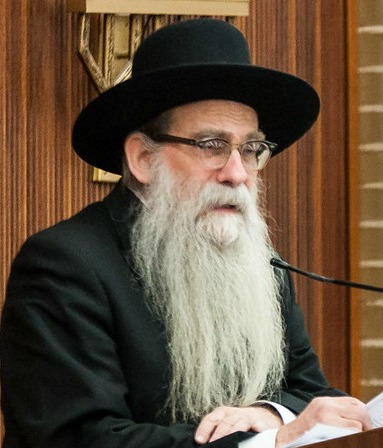Reworded by Rabbi Yair Hoffman from a Vaad given and printed in 5784. Klal Yisroel is blessed that we have Gedolei Torah such as Moreinu HaGaon HaRav Olshin shlita. This thought on the parsha has been adapted for easier comprehension. To subscribe to a weekly parsha sheet on the topic of Integrity from the parsha please send the word “Subscribe” to [email protected].
At the beginning of Parshas Chayei Sarah, the Torah tells us “Sarah died in Kiryas Arba, which is Hebron, in Canaan, and Avrohom Avinu came to eulogize Sarah and weep for her.” The pasuk makes it clear that Avrohom Avinu wasn’t at home in Hebron with Sarah at the time of her death. The Ramban explains that after the Akeidah, Avrohom didn’t return to his home in Hebron. Instead, he traveled to his Eshel in Be’er Sheva to give thanks for the miracle he had just experienced. Avrohom Avinu had just witnessed the survival of Yitzchok and went directly to his Eshel to thank Hashem for this miracle.
The Fundamental Question
Rav Meir Soloveitchik raises a compelling question regarding Avrohom Avinu’s choice of location. Why didn’t Avrohom give thanks on Har Moriah itself, the place that Yaakov would later refer to as the “Gateway to Heaven?” Surely he knew that this was the best place of prayer. Why would he travel to Be’er Sheva to thank Hashem?
Understanding Avrohom Avinu’s Choice
Rav Meir explains that while Avrohom Avinu could indeed have given thanks right there on Mount Moriah, he specifically wanted to thank Hashem in public – “בתוך רבים אהללנו”. He therefore went to his Eshel, a place where travelers from around the world passed through, ensuring his gratitude would be expressed publicly. However, the Ramban’s language –“to his Eshel” – suggests there was more to this choice. He didn’t just go to any public place; he went specifically to his Eshel. This detail reveals a deeper dimension to Avrohom Avinu’s gratitude.
The Nature of True Gratitude The Prayer of Nishmas
In the Tefilah of Nishmas, we express the limitless nature of our obligation to thank Hashem through some powerful metaphors: (1) Even if our mouths were as full of song as the sea itself, (2) our tongues as rich with melody as the countless waves, (3) our lips as expansive with praise as the breadth of the heavens, (4) our eyes as radiant as the sun and moon, (5) our hands spread as wide as eagles’ wings in the sky, and (6) our feet as swift as deer – even then, we would be unable to thank Hashem adequately for even one of the millions of favors done for our ancestors and for us. The inclusion of physical attributes like hands and feet presents a puzzle. While the role of the mouth and tongue in offering praise is obvious, how do hands and feet participate in expressing gratitude? This question leads us to the teachings of the Chovos HaLevavos, who says that true gratitude must extend beyond verbal expression to encompass action and service.
In his introduction to Sha’ar Avodas HaElokim, he writes that an intellectual person will clearly understand his obligation to accept divine service through reason and logic alone. This is in addition to all the proofs that Hashem showed us and the incredible miracles performed during the Exodus from Egypt, at Har Sinai, and throughout the years in the desert.
He teaches that the more benefits one receives from Hashem, the more one must increase and improve his divine service. This principle is demonstrated through the laws of Ma’aser (tithing). The Torah commands “one must give a tenth of his produce.” Thus, someone who receives one hundred kur of grain must give ten kur, while someone who receives ten kur gives one kur. If the person with one hundred kur gives only nine and a half, they are punished, while the person who has ten and gives one is rewarded.
This same principle applies to every aspect of divine service. When people receive specific benefits from Hashem that others don’t have, they have a particular obligation to enhance their service to Hashem. This concept applies not just to individuals but to families and nations as well.
Historical Examples and Their Significance The Complainers in the Desert – The case of the mis’onenim (complainers) in the desert illustrates the severity of failing to recognize divine kindness. These individuals were severely punished because they focused solely on their complaints while failing to acknowledge the extraordinary benefits they were receiving. As the Rosh Yeshiva, Rav Shneur zt”l, frequently taught, their punishment was particularly harsh because they failed to see and feel all the incredible kindnesses that Hashem had done for them. By focusing on the complaints, they undermined a fundamental principle of divine service and deprived themselves of one of the greatest motivators for serving Hashem.
Dovid HaMelech’s Institution of 100 Blessings
During Dovid HaMelech’s time, a plague struck Klal Yisroel, claiming one hundred lives daily. In response, David instituted the requirement to recite one hundred blessings each day. The Levush explains that this wasn’t an arbitrary response but was based on divine inspiration. Through ruach hakodesh (divine inspiration), David perceived that the plague resulted from insufficient recognition and blessing of Hashem for His constant kindnesses. The Levush further explains that these hundred blessings were established in accordance with the natural order of the day – corresponding to the consistent flow of divine goodness that each person receives through daily life. There is a blessing for every kindness, for every gift, for every moment of the day. As the pasuk states, “blessed is Hashem, day by day.” We must bless Hashem consistently, just as He consistently blesses us. The failure to maintain this recognition and gratitude had brought about the terrible plague.
The Miracle of Jewish Survival
Rav Yaakov Emden presents a new perspective on Jewish survival through history. He notes that we are the nation of exile, the wandering sheep who have endured unspeakable troubles for thousands of years. No other nation has been persecuted as we have. Throughout history, mighty nations and empires have stood against us to destroy us completely – a pattern we continue to witness today. Their hatred, rooted in jealousy, has caused us endless suffering.
Yet remarkably, while great nations and empires of antiquity – the Babylonians, Romans, and Greeks – have vanished completely, the Jewish people, who cleave to Hashem, remain alive and well. Through all the incredibly long years of this terrible exile, not even one letter or vowel mark of the Torah has been changed. We haven’t abandoned even one word of the Sages’ teachings. The entire Torah remains completely intact, unaffected by time. Rav Yaakov Emden makes an astounding declaration: “By his life, he swears that when he contemplates these wonders – the miracle of our survival and the preservation of Torah in its pure form – he realizes they are greater than all the miracles Hashem performed for us in Egypt, in the desert, and in the Land of Israel.” Moreover, he adds that the longer the exile continues, the more obvious and truthful this miracle becomes, and the more recognizable its greatness becomes.
The Promise of Greater Miracles
This understanding helps resolve the Ramban’s question about Hashem’s promise after the sin of the Golden Calf: – Hashem promises to perform wonders that had never been seen before. The Ramban questions how this could be possible, given that the greatest miracles – the ten plagues and the splitting of the Red Sea – had already occurred. Rav Shach explains, based on Rav Yaakov Emden’s insight, that Hashem was promising an even greater miracle: the survival of the Jewish people and the Torah throughout thousands of years of exile. This miracle grows greater and more apparent as the exile lengthens and becomes more difficult, surpassing even the spectacular miracles of the Exodus.
Contemporary Application
Our obligation today is multifaceted. We must recognize both the personal blessings we receive and the ongoing national miracle of Jewish survival. As the Chovos HaLevavos teaches, this recognition must extend beyond verbal expression to impact our actions and service. The sages tell us we must constantly ask ourselves, “What did our forefathers do that made Hashem desire them so much? We must strive to reach their level, as expressed in the saying – When will my deeds reach the level of our forefathers’ deeds?
From Avrohom Avinu’s example, we learn to respond to divine kindness with increased service. Just as he rushed to his Eshel to thank Hashem through enhanced service, we must thank Hashem for our daily miracles of survival. This is particularly crucial during times of trouble. While we must certainly pray for those who suffer, we must simultaneously express gratitude for all the kindnesses we receive – both personal and national – through more Torah study, more focused prayer, and increased dedication to Mitzvos and Chessed. This comprehensive approach to gratitude, combining recognition with action, not only follows Avrohom’s example but fulfills our obligation during both times of blessing and challenge. Through such proper thanks, we may merit salvation from our current troubles.
If you are interested in receiving these regularly and wish to help please contact Yairhoffman2@gmail











